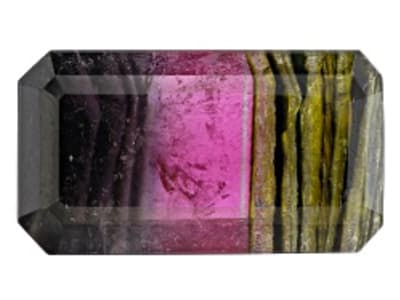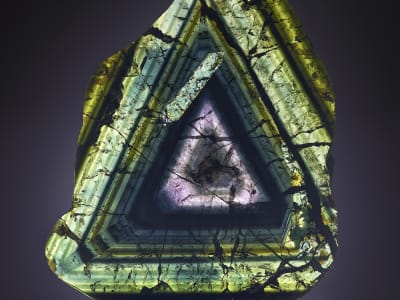Liddicoatite is a calcium-rich lithium species of tourmaline named in 1977 in honor of noted gemologist Richard T. Liddicoat. Gems may form in green, pink, red, blue and purple colors, sometimes with internal multicolor banding and zoning. Large crystals are often sliced to display their natural multicolor designs.
General Information
Common Name
Liddicoatite
Species
Tourmaline
Transparency
Transparent - Translucent
Dispersion
Strength: Weak Fire Value: 0.017
Refractive Index
1.621-1.627
Tolerance:(+0.011/-0.009)
Tolerance:(+0.011/-0.009)
Birefringence
0.018-0.02
Optic Character
Uniaxial
Optic Sign
Negative
Polariscope Reaction
Doubly Refractive (DR)
Fluorescence
SWUV: Inert
LWUV: Inert
LWUV: Inert
CCF Reaction
None
Pleochroism
Dichroic, moderate to strong, varying shades of body color
Hardness
7.5
Streak
Light Brown, White
Specific Gravity
3.02-3.05 Typical: 3.020
Toughness
Good
Inclusions
Liddicoatite is a type II clarity stone. Stones might contain liquid and gas inclusions that are long and thin, reflective gas-filled fractures and color zoning.
Luster
Vitreous
Stability
Very Good
Fracture
Conchoidal, Uneven
Cleavage
Poor, in two directions
Chemical Name
calcium lithium aluminum bora-silicate hydroxide
Chemical Formula
Ca(Li2Al)Al6(Si6O18)(BO3)3(OH)3(OH)
Crystal System
Trigonal
Chemistry Classification
Silicate
Liddicoatite Colors
-
 Blue
Blue -
 Brown
Brown -
 Green
Green -
 Multi-color
Multi-color -
 Pink
Pink -
 Red
Red
Alternate Names
Fluor-Liddicoatite
Countries of Origin
Tanzania, United Republic Of; Russian Federation; Viet Nam; Czechia; Sri Lanka; United States of America; Madagascar; Portugal; Canada; Sweden; Unknown; Norway; Brazil; Poland; Italy; Nigeria
Care
Normal Care

